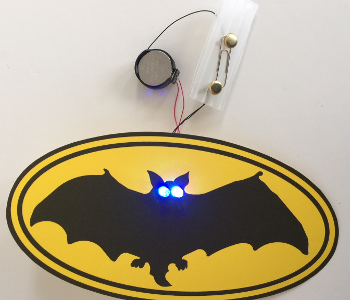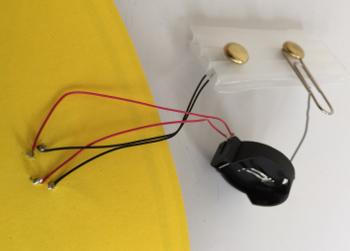diy-blinky-bot
BAT BADGE BLINKY-BOT INSTRUCTABLE

WESTERN CANADIAN ROBOTICS SOCIETY
Get the Supplies

- 1 – bat body printed on yellow card stock
- 1 – bar pin
- 3 – 8 cm pieces of black AWG 30 wire (stripped ~1 cm on both ends)
- 2 – 8 cm pieces of red AWG 30 wire (stripped ~1 cm on both ends)
- 1 – coin cell battery holder
- 1 – 3V coin cell battery (CR 2032)
- 2 – fast blink multi-coloured LEDs
- 1 – paper clip
- 2 – brass brads (~1.25 cm)
- 1 – 2.5 cm x 7 cm corrugated cardboard or plastic piece, with 2 holes drilled/punched 2.5 cm apart closer to one end
Note: A template for the bat body can be found here: BatBadge-template.pdf. Print it on yellow card stock.
Assemble the Tools

- safety glasses
- hot glue gun (with glue stick)
- white glue
- scissors
- wire cutters
- wire wrap tool
- soldering iron (with solder)
- needle nose pliers (optional)
- toothpick (glue applicator)
- straight pin
- small container
Getting Started
-
Place the supplies into a small container to keep small parts from getting lost.
-
Cut out around the outside of the oval shape.

Install the LEDs
-
Locate the two LEDs and the straight pin. With the straight pin, punch two holes in each of the bat’s eyes for the LEDs. Look at an LED and note how far apart the leads are; this is how far apart the two holes need to be. One lead of the LED needs to go through each hole.
-
Install the LEDs through the holes. With a toothpick, place a small dab of glue under each LED (optional, but recommended for younger makers). Push the LEDs all the way down flat against the card stock. Turn the bat face down and set aside to dry.

Assemble the Switch
-
Locate the two brass brads, the corrugated rectangle, and the paperclip. Assemble the switch from these parts according to the picture below.
-
Put one brad through one of the holes in the rectangle. Spread the wings on the other side to keep it in place.
-
Put the other brad through the small end of the paper clip and install it through the other hole of the rectangle. Spread the wings on the other side.

- Locate two black wires. Holding the two wires parallel, with the ends lined up, twist the stripped ends (the silver parts) together. One end of the wires only.

- Bend a loop in the twisted part of the pair of wires. (Hint: Wrapping the wire around the tube of the wire-wrapping tool is a convenient way to form the loop.)

- Working on the back side of the switch, slide this loop around one of the wings of a brass brad and into the centre of the brass brad. The silver (uninsulated) end needs to be on top. That is the piece to be soldered.

-
Solder these wires to the centre of the brass brad. Let the solder cool for a few seconds and then test to make sure the solder job is secure by tugging gently on the wires.
-
Locate another black wire. Solder it to the other brass brad. Do this the same way that you just attached the first two wires, only this time you are only soldering a single wire. Test the wire to make sure it is soldered securely.

Soldering Hints: When soldering, remember to heat the soldering point with the soldering iron before bringing in the solder. Hold the soldering iron at a low angle to the soldering point to provide sufficient contact for good heat transfer. Keep the soldering iron in place when you bring the solder in to the soldering point. Always return the soldering iron to its holder; never lay a soldering iron down on a worktable.
Assemble the Battery Holder
-
Locate the battery holder and two red wires. Turn the battery holder upside down so the pins are exposed.
-
Using the wire wrap tool, attach one red wire to the positive pin (larger and square end) of the battery holder. Attach the second red wire to the same pin (positive).
-
Solder the red wires in place. (Very little solder is required for soldering pins. Remember to heat the pin before bringing in the solder.)

Wire-wrapping Hints: When loading the wire-wrapping tool, try to avoid bending and kinking the wire. Do not feed the insulated part of the wire into the tool. When spinning the tool, place a finger over the wire near the tool to keep the insulated part of the wire from being caught up in the wrapped wire. If the tool does not spin freely, it probably means that you have inserted the pin in the outside hole, rather than the centre hole; lift the tool and try again.
Connect the Switch
- Using the wire wrap tool, attach the single black wire from the switch to the negative pin (smaller, rounder end) of the battery holder. Solder in place.

Connect the LEDs
-
Note that the LEDs have a long lead and a short lead. The long lead is positive and the short lead is negative.
-
Using the wire wrap tool, attach one red wire from the battery holder to each of the positive (long) LED leads. Make sure to push the wire wrap tool all the way down to the card stock before wrapping the wire, as the LED leads will be trimmed down later.
-
Using the wire wrap tool, attach one of the black wires from the switch to each of the negative (short) LED leads.

Test it out!
-
Close the switch. (Move the paper clip across the two brads)
-
Put the battery into the battery holder with the positive (+) side up. It is not necessary to ‘click’ the battery into place. Simply holding it in place is enough to complete the circuit. Make sure that both of the LEDs are blinking. If not, you have some trouble-shooting to do (e.g., weak solder joints, backward wiring, wires bridging LED leads, upside down battery).

- Remove the battery and open the switch. To remove the battery (when fully inserted), squeeze the metal tab on the top side, located at the positive end of the battery holder. (If finger pressure does not work, needle nose pliers may be needed.)
Solder the LED leads
-
Solder each of the four LED leads. (Be careful not to bridge the leads with solder or you will create a short and the LED will not work.)
-
Test the circuit and make sure that the LEDs are still working.
-
Put on safety glasses and make sure anyone around you puts on safety glasses too.
-
Using wire cutters, trim the LED leads one at a time to 0.5 cm. Make sure you hold onto the LED lead so it does not go flying and hurt someone. Also, be careful not to cut any of the red and black wires.

Finishing
-
Put some hot glue on the top of the switch rectangle, on a corner of the end away from the paperclip and brads. Press the back of the battery holder down into the glue, so that the two soldered pins go past the side and end of the rectangle (diagonal across the corner). Do not worry if glue gets on the wires.
-
Put some hot glue on the bottom of the switch rectangle. Press the switch down onto the centre of the oval. Positioning the badge so that most of the oval is on the table, with the eyes over the edge, makes it easier to press the switch down.
-
Locate the bar pin. Run a short bead of hot glue along the top backside of the oval. Carefully press the bar pin into the hot glue. (This pin is for pinning the bat onto clothing or a lanyard.)
-
Test the circuit one last time, this time fully inserting the battery until it clicks in place (this often requires a fair bit of force).


- VOILA! You are done!
Note: The switch can be closed more securely by sliding the paperclip under the edge of the head of the brass brad.
